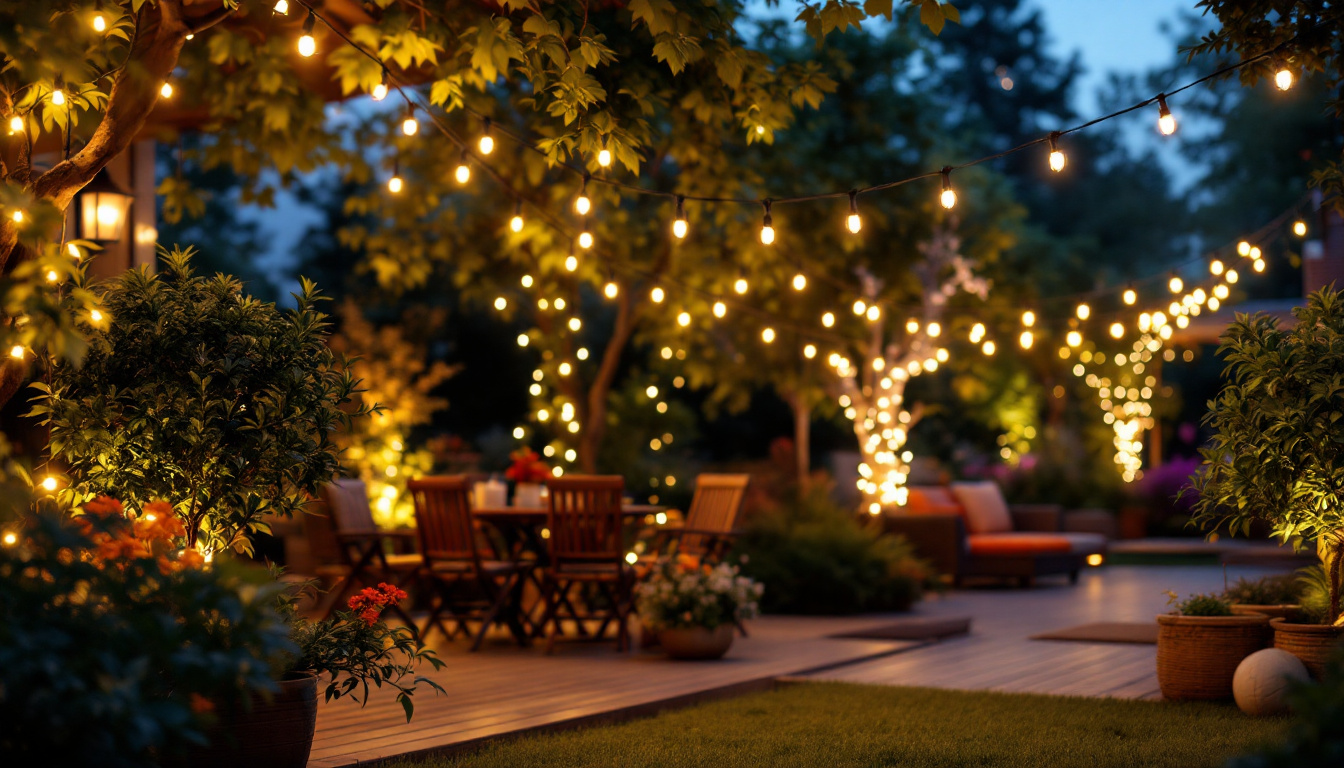

Outdoor patio string lighting has become an essential element in creating inviting and aesthetically pleasing outdoor spaces. As a lighting contractor, understanding the nuances of string lighting installation can set your services apart. However, there are common pitfalls that can lead to less-than-satisfactory results. This guide aims to highlight these mistakes and provide actionable insights to ensure successful installations that delight clients.
Before diving into the common mistakes, it’s crucial to understand the fundamentals of outdoor string lighting. String lights are flexible, versatile, and can enhance the ambiance of any outdoor setting. They come in various styles, lengths, and bulb types, allowing for creative installations that can cater to different client preferences. From rustic bistro lights to modern fairy lights, the options are endless, and each style brings a unique charm to the environment.
When planning a string lighting project, consider the intended atmosphere. Is the goal to create a cozy, intimate setting for gatherings, or a bright, festive environment for celebrations? Understanding the desired mood will guide the selection of styles and placement of lights. For instance, warm white lights can evoke a sense of comfort, while colorful bulbs can energize a space for lively events. Additionally, layering different types of lighting can add depth and dimension, enhancing the overall aesthetic appeal.
Not all string lights are created equal. It’s essential to choose lights that are specifically designed for outdoor use. These lights are typically weather-resistant and constructed to withstand various environmental conditions. Using indoor lights outdoors can lead to premature failure, resulting in dissatisfaction from clients. Furthermore, outdoor string lights often come with features such as shatterproof bulbs and UV protection, ensuring durability and longevity even in harsh weather.
Additionally, consider the type of bulbs. LED bulbs are energy-efficient and long-lasting, making them a popular choice for outdoor lighting. However, incandescent bulbs offer a warm glow that many clients may prefer for their outdoor spaces. Understanding the pros and cons of each option can help in making informed recommendations. For example, while LED bulbs may have a higher initial cost, their energy savings and lifespan can make them more cost-effective in the long run. Moreover, some clients may appreciate the option of smart string lights, which can be controlled via smartphone apps to adjust brightness and color settings, adding an element of convenience and customization.
One of the most common mistakes made by lighting contractors is miscalculating the amount of string lighting needed for a space. Too few lights can leave areas dim and uninviting, while too many can create a harsh and overwhelming environment. A balanced approach is essential.
To determine the right amount, consider the size of the area and the desired brightness. A general rule of thumb is to use 10 to 20 feet of string lights for every 100 square feet of space. However, this can vary based on the specific layout and design preferences of the client. Additionally, it’s important to take into account the height at which the lights will be hung and any surrounding structures that may cast shadows. For instance, if the lights are draped across a patio or garden, they should be positioned to create a soft glow that highlights the area without overwhelming it. Using dimmers or adjustable fixtures can also help in achieving the perfect balance, allowing clients to tailor the lighting to their specific needs and occasions.
The installation process is where many contractors can falter. Proper installation is crucial for both aesthetics and functionality. Mistakes made during this phase can lead to safety hazards, increased maintenance, and unhappy clients.
One significant mistake is failing to establish adequate support for the string lights. String lights should be hung securely to prevent sagging or falling, which can pose safety risks. Using sturdy poles, trees, or existing structures can provide the necessary support.
Additionally, consider the height at which the lights are installed. Lights that are too low can obstruct movement and create hazards, while lights that are too high may not provide the desired illumination. A careful assessment of the space will help determine the optimal height for installation. Furthermore, using adjustable mounting hardware can allow for flexibility in positioning, ensuring that the lights can be easily modified in the future if needed. This adaptability can be particularly beneficial in outdoor settings where landscaping changes or seasonal adjustments may be required.
Electrical safety is paramount in any lighting installation. One of the most common oversights is not adhering to local electrical codes and regulations. Failing to comply can lead to dangerous situations and legal ramifications.
Ensure that all electrical connections are weatherproof and that extension cords used outdoors are rated for outdoor use. Additionally, using GFCI (Ground Fault Circuit Interrupter) outlets can help prevent electrical shock, providing peace of mind for both the contractor and the client. It’s also wise to regularly inspect the electrical components for wear and tear, as exposure to the elements can degrade materials over time. Implementing a maintenance schedule can help catch potential issues before they escalate, ensuring the longevity of the installation and the safety of those who enjoy the illuminated space.
Design plays a crucial role in the effectiveness of string lighting. A well-thought-out design not only enhances the visual appeal but also ensures that the lighting serves its intended purpose. Here are some design considerations that contractors should keep in mind.
String lights can be used to create a focal point in an outdoor space. This could be a dining area, a fire pit, or any other gathering spot. By strategically placing lights around these areas, contractors can draw attention and create a warm, inviting atmosphere.
Consider using varying lengths of string lights to add depth and dimension. For example, draping lights in a zigzag pattern can create visual interest, while straight lines can offer a more modern look. Understanding the client’s style preferences will help in crafting a design that resonates with them.
String lights can work harmoniously with other outdoor lighting elements, such as lanterns, spotlights, and pathway lights. A layered lighting approach can enhance the overall ambiance and functionality of the space. For instance, combining string lights with soft landscape lighting can create a magical evening setting.
When incorporating multiple lighting types, it’s essential to maintain a cohesive design. This can be achieved by selecting lights that share similar styles or color temperatures, ensuring that the overall look is unified and appealing.
Once the installation is complete, the focus should shift to maintenance and ensuring the longevity of the string lights. Educating clients on proper care can enhance their satisfaction and prolong the life of the installation.
Encourage clients to conduct regular inspections of their string lights. This includes checking for any damaged bulbs, frayed wires, or loose connections. Addressing these issues promptly can prevent larger problems down the line and ensure that the lights remain functional and safe.
Additionally, seasonal maintenance is essential, especially in areas with harsh weather conditions. Removing lights during extreme weather can prevent damage and extend their lifespan. Providing clients with a simple maintenance checklist can be a valuable resource.
Offering replacement services for damaged bulbs or components can be an excellent value-add for contractors. Many clients may not know how to replace bulbs or may not have the time to do so. By providing this service, contractors can enhance their reputation and foster long-term relationships with clients.
Furthermore, keeping a stock of commonly used bulbs and accessories can streamline the process and ensure that replacements are readily available when needed. This proactive approach can significantly improve client satisfaction.
Clients often come with preconceived notions about outdoor string lighting that may not align with best practices. Addressing these misconceptions can help in managing expectations and ensuring a successful project.
One common misconception is that all string lights are interchangeable. Clients may not understand the differences in quality, durability, and design. Educating them on the benefits of using high-quality, weather-resistant lights can help justify the investment in a more premium product.
Additionally, clients may not realize that the installation process can vary significantly based on the type of lights chosen. Providing clear explanations and examples can help clients make informed decisions and appreciate the value of professional installation.
Clients may also underestimate the importance of planning when it comes to string lighting. They might envision a simple installation without considering factors such as layout, electrical requirements, and design aesthetics. Taking the time to discuss these elements during the planning phase can lead to a more successful outcome.
Encouraging clients to visualize their space and discuss their goals can help in creating a tailored lighting plan that meets their needs and exceeds their expectations.
Outdoor patio string lighting can transform a space, creating an inviting atmosphere for gatherings and relaxation. However, as a lighting contractor, it’s essential to avoid common mistakes that can compromise the quality and safety of installations. By understanding the basics, adhering to safety standards, and considering design elements, contractors can deliver exceptional results that delight clients.
Education plays a crucial role in successful installations. By guiding clients through the selection process, installation, and maintenance, contractors can build trust and establish long-term relationships. In a competitive market, attention to detail and a commitment to quality can set a contractor apart, ensuring that every outdoor lighting project shines brightly.
Ready to elevate your lighting installations with the highest quality string lights and accessories? Look no further than LumenWholesale, where we offer contractors spec-grade lighting products at unbeatable wholesale prices. Our extensive selection not only meets but exceeds industry standards, ensuring that your projects shine with reliability and high performance. Plus, with free shipping on bulk orders, you can enjoy premium lighting solutions at the best value — all without hidden fees or compromises. Make your next outdoor patio string lighting project a glowing success with the perfect blend of quality, affordability, and convenience at LumenWholesale.

Discover the secrets to maximizing efficiency in warehouse lighting with our comprehensive guide.

Discover essential insights into bathroom lighting fixtures that every lighting contractor should know.

Discover essential insights into construction and portable lighting tailored for lighting contractors.

Discover the innovative strategies lighting contractors use to maximize efficiency with high bay LED lights boasting 30,000 lumens.
Get notified when NEW deals are released.
Optimize your budget with wholesale discounts.
Only top-quality, specification-grade lighting products.
No additional costs at checkout - what you see is what you pay.
We understand the unique needs of contractors.